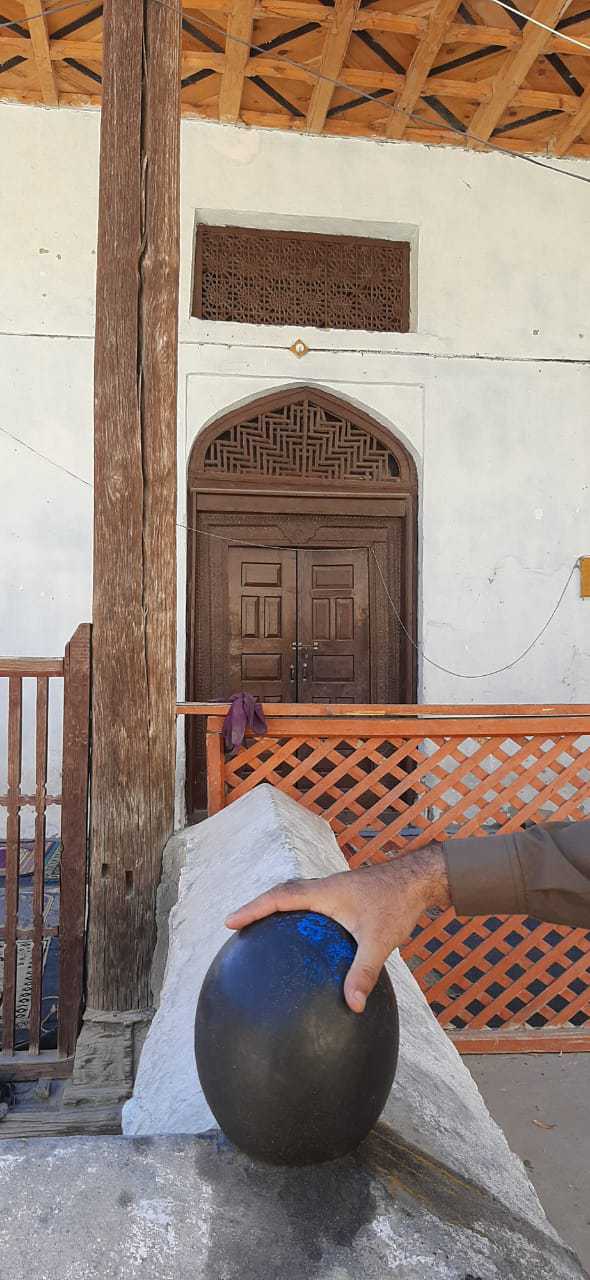After Ghorse, the direction of the valley changes again and then from Haldi village the Siltru Siachen region begins. Haldi village is unique and distinguished in many ways.
It is mentioned in the history that Yabgu dynasty had its original base in Takht Haldi after Fadwa and from there the capital was shifted to Nawam during the reign of Salim Ulde in the 15th century AD. On a mound on the bank of the river at Haldi, remains of the ancient fort still exist in the form of collapsed walls and heaps of stones. At Haldi, there are also stone carvings and petroglyphs, which are a sign of the importance of the place and its importance.
Above all, Haldi is the birthplace and burial place of Bua Johar, a high-ranking person of Sufism and poetry. According to the plaque in his mausoleum Aqdas, the date of Bua Johar’s purdah decree is stated to be between 1901 and 1905.
Wherever there are old hermitages in Baltistan, they are built according to the traditional style of architecture and even now the hermitages of the elders are being built under this style.
Agha Ali Mousavi’s mausoleum Hussainabad Skardu and Sheikh Ghulam Hussain Sahar’s mausoleum Aqdas Chorka Shagar are the latest examples of this traditional style of architecture. But it is a pity that an attempt has been made to build Bua Johar’s mausoleum with cement and clay, which is still not complete.
Boa Johar’s poetry exists in the form of Bahr Tawal, which may be as many as 26 in number. In 2015, prominent researcher Mohammad Hasan Hasrat edited the personality and works of Bua Johar under the name of ‘Johar Baltistan’. In this book, Hasrat Sahib has collected about ten long seas. He also commented on the artistic merits of Boa Johar.
In page 31 of the book there is a mention of an incident, according to which once there was a famine in Baltistan, Bua Johar was also badly affected by it and he wrote a letter to Raja Hatim Khan Hatim of Nawab. According to Hasrat Sahib, Raja Sahib was shaken after reading this piece and provided suitable assistance. Hasrat Sahib also gave a section in Balti language.
I have been fortunate to have been associated with Mr. Syed Ali for the past few years. Sayyid Ali Sahib is one of the descendants of Mir Arif’s daughter Nik Akhtar Sharaf-ul-Nisa, who was married to Mir Mukhtar’s son Mir Ishaq. Syed Ali is a retired headmaster and a resident of Chhawar Chhorbat. He is very meek, humble and full of knowledge and literature. He is well versed in history, Sufism, archeology and religious education and even has a good knowledge of the Balti language ‘Age’. Although Mirwaiz is a family member, he is free from any kind of manipulation and trouble.
He has collected many books on mysticism. Especially the manuscripts are preserved with him in large numbers.
Syed Ali Sahib kindly provided me with a letter written by Bua Johar and sent to Raja Nawam for my perusal. The letter is in Persian and is written on a column-sized piece of paper.
This letter was also written to help Raja Sahib. Its details will be discussed later.
Central to all the words of Bua Johar is Madhut Panjatan Pak, the impermanence of the world and the attainment of self-purification, which is in the color of Sufism.
Mir Taqi Mir has said what!
Breathing slowly is a delicate task
Of Afaq, this work of Shisha Giri
The next village after Haldi is Thugas. It is also a traditional village located at the foothills of the Karakoram mountain range. Snowy water from a mountain stream divides the village of Thugs. The village is on a sloping level, with terraced fields and beautiful apricot orchards.
The village has a grand monastery and two beautiful hermitages at its side.
The design of the monastery is of the same style, which is traditionally found everywhere in Baltistan. That is, first there is a high porch and then the main gate of the monastery. Two more doors are built on either side of the main door. On the front of the door frame of the Sadr door, usually in Persian, the history of the construction of the monastery and the skilled artisans are mentioned. The main hall is quite large and high-ceilinged, with geometric designs and carvings. A special interior roof design is called hatim band, which is often built in monasteries. Rounds of solid wood, of considerable circumferential thickness, are installed to support the roof. The main feature of the monastery is the meditation rooms on the two sides of its main hall to provide solitude for self-purification, mental relaxation and contemplation. They are called Chala Khoro in the local Balti language. The outer walls of the monastery are built under a special style of wooden construction, known as thattar, over which thick clay plaster is applied.
Above the monastery is a special wooden dome with a cloister in the center of the roof, commonly called a Tibetan tower. But I have not seen this dome in any picture of any Tibetan architecture building. A dome of the same style is also built in the mosque attributed to Hazrat Amir Kabir Syed Ali Hamdani in Srinagar.
The mention was being made of the monasteries of Thugs and Xhenu. The importance of Thugswali monastery is even more in the sense that Mir Arif and Mir Abu Saeed are buried on its side and their small shrines of unique design are references.
Mir Arif and Mir Abu Saeed were brothers, who came to Baltistan from Kashmir in the 18th century AD and were descendants of Mir Shamsuddin Iraqi. Mir Arif stayed in Thugs, while Mir Abu Saeed went to Keris and stayed.
Mir Ishaq was the son of Mir Mukhtar Akhyar and settled in Thugs from Keris. He was the son-in-law of Mir Arif. Mir Arif built Thugs monastery.
When we arrived at Thugs Monastery on September 20, 2024, it was undergoing some renovation work. The old plaster of the outer walls was stripped.
The dignitaries there said that there is also a plan to replace the rotten wood of the roof. It was deeply saddened to see that the beautiful Astanas of Mir Arif and Mir Ishaq, which were made of wood and were magnificent examples of the architecture of Baltistan, have been damaged. I don’t know which Aristotle advised and who provided the money that the roofs of the two monasteries have been raised and iron sheets have been added. More ironically, the unique design lattices on the walls have been removed and replaced with machine-made artificial lattices of plywood. Ironically, green color has been painted on both the shrines without any thought.
The deterioration of historical and religious buildings is certain and renovation work is also necessary, but for this it is very important to take into account the architectural style and historical importance of these buildings apart from the contract or target approach.
Behind the design and architectural features of these buildings lies a vast history and culture which is a great sign of our cultural heritage.
It is necessary that utmost care should be taken in the maintenance and renovation work of this type of buildings so that no deterioration occurs in the original form. In this regard, AKCSP has highlighted the importance of architectural heritage by restoring some forts, monasteries and hermitages and has provided standard guidelines for such renovation works.
Thugs is an apparently average village, but its historical significance has been changing for the past few years. Various artifacts have been found here during the excavation of old collapsed houses and fields.
These include Tibetan beads, ornaments of various designs, old handwritten books, beads and pottery. A variety of items are included. From which it seems that this village has been an ancient and important civilization.
A short distance from Thugs, another magnificent monastery can be seen on the side of the road leading to Dum Sim. This is Xhenu village. Zhino is also a small rural village similar to Thugs, which has the same geographical structure as Thugs. Behind the village there is a high mountain range and beyond here the hills up to Siltru and Khorkundu have a distinct beauty. The vertical cliffs are perfectly pointed and made of granite and are so clean that they seem to have been washed by the clouds every day. A towering granite tower looms majestically in the mountain pass of Jhenu village.
This section contains related reference points (Related Nodes field).
This granite outcrop looks exactly like the Trango Tower and from its side the cold water of the glaciers flows in a gushing stream towards the village.
On the banks of the same canal, the Xhenu Monastery stands out majestically on the huge stone platforms.
The western part of the monastery, which is visible from the road, has a combination of mud and lime plaster. There are two windows in the middle of the same wall and above them are five latticed medium-sized carved roshan dans.
The verandah of the monastery is worth seeing. It stretches from north to south. The part that protrudes outwards has 14 medium-sized pillars, with wooden latticework and distinctive designs on the floor and ceiling parts. The inner roof of the porch is quite high and entirely made of wood, the part above the main entrance of the monastery is finished in balsam while the parts on both sides are also made of square designs with wooden planks. Black lines are drawn in them.
The main door of the monastery and the frames of the other two adjacent doors have very fine and decorative work. They have frilled floral designs and impressions, while the names of the year of construction, Karigar and Panjatan Pak are inscribed in Persian with half-disc shaped wood on the forehead of the frames.
As soon as you enter the main hall, you will see the meditation rooms on the right and left, with carpets and other arrangement on the floor.
Six tall conical wooden pillars support the roof of the monastery and the ornamentation and design of the inner ceiling is worth seeing.
There are many graves in the deserted compound of the monastery and there are two tombs here, which are in a very dilapidated condition. They are made of wood and it seems that some dignitaries are buried here. The woodwork of both tombs has rotted and the roofs have collapsed. The wood in one of the tombs has very ornate carvings, while in the other, the wood is simply carved. They are in dire need of renovation work.
At the beginning of the pass in the hill of the village, there is a little flat land with the mountain on the elevation, there are traces of an old building.
Local people say that it was a Manchu fort which now exists in the form of a pile of stones. This strategically important fort is part of the ancient remnants of a time when separate independent tribal governments were established in the region.













